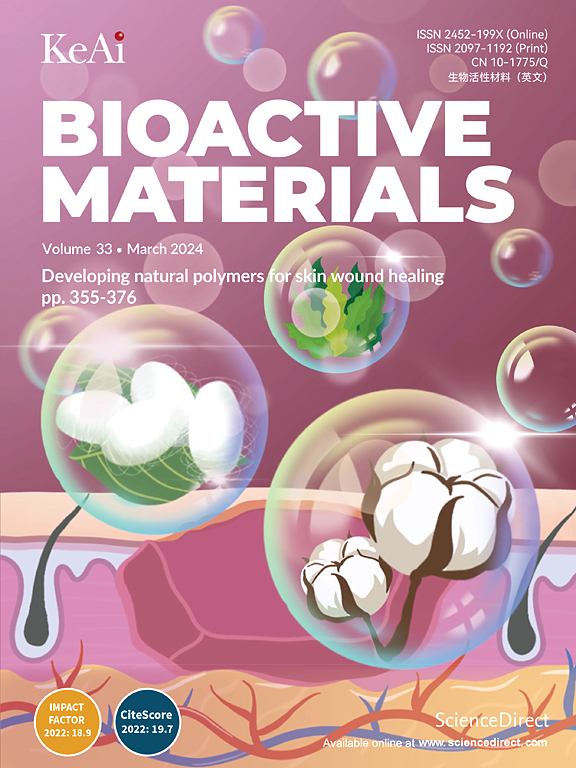A sequential drug delivery system based on silk fibroin scaffold for effective cartilage repair
IF 18
1区 医学
Q1 ENGINEERING, BIOMEDICAL
引用次数: 0
Abstract
Endogenous repair of cartilage defects is a preferential strategy for cartilage repair, but always hindered by insufficient early-stage cells and incomplete cell differentiation at later stages. For in-situ cartilage regeneration, it is crucial to develop a sequential drug release system capable of recruiting endogenous bone marrow mesenchymal stem cells (BMSCs) and promoting their chondrogenic differentiation. Herein, based on our long-term and fruitful research on silk fibroin (SF) porous scaffolds, a cell-free sequential drug delivery SF scaffold was developed. BMSCs affinity peptide PFSSTKT (PFS) was coated on the surface of SF scaffold, in which chondrogenic inducer kartogenin (KGN) and anti-inflammatory factor dexamethasone (DEX) were loaded. PFS was rapidly released within the first 10 days while KGN and DEX could be released over 28 days. The scaffold promoted BMSCs migration and chondrogenic differentiation through the release of PFS and KGN in vitro. Finally, the sequential drug released by the implanted SF scaffolds in rats indeed recruited endogenous BMSCs and significantly promoted the in-situ regeneration of their knee cartilage defects. In summary, this study not only introduces a green and environmentally friendly all silk-based sequential drug delivery system, but also provides an effective tissue engineering functional scaffold for in-situ cartilage regeneration.

一种基于丝素蛋白支架的连续给药系统用于软骨的有效修复
软骨缺损的内源性修复是软骨修复的优先策略,但由于早期细胞不足和后期细胞分化不完全,软骨缺损的修复往往受到阻碍。对于原位软骨再生来说,开发一种能够募集内源性骨髓间充质干细胞(BMSCs)并促进其软骨分化的序贯药物释放系统至关重要。本文在对丝素蛋白多孔支架长期卓有成效的研究基础上,研制了一种无细胞序贯给药的丝素蛋白多孔支架。将骨髓间充质干细胞亲和肽PFSSTKT (PFS)包被在SF支架表面,并在支架表面加载软骨生成诱导剂kartogenin (KGN)和抗炎因子地塞米松(DEX)。PFS在前10天内迅速释放,而KGN和DEX在28天内释放。支架通过释放PFS和KGN促进骨髓间充质干细胞迁移和软骨分化。最后,大鼠植入SF支架后释放的序次药物确实募集了内源性骨髓间充质干细胞,并显著促进其膝关节软骨缺损的原位再生。综上所述,本研究不仅引入了一种绿色环保的全丝基序贯给药系统,而且为原位软骨再生提供了一种有效的组织工程功能支架。
本文章由计算机程序翻译,如有差异,请以英文原文为准。
求助全文
约1分钟内获得全文
求助全文
来源期刊

Bioactive Materials
Biochemistry, Genetics and Molecular Biology-Biotechnology
CiteScore
28.00
自引率
6.30%
发文量
436
审稿时长
20 days
期刊介绍:
Bioactive Materials is a peer-reviewed research publication that focuses on advancements in bioactive materials. The journal accepts research papers, reviews, and rapid communications in the field of next-generation biomaterials that interact with cells, tissues, and organs in various living organisms.
The primary goal of Bioactive Materials is to promote the science and engineering of biomaterials that exhibit adaptiveness to the biological environment. These materials are specifically designed to stimulate or direct appropriate cell and tissue responses or regulate interactions with microorganisms.
The journal covers a wide range of bioactive materials, including those that are engineered or designed in terms of their physical form (e.g. particulate, fiber), topology (e.g. porosity, surface roughness), or dimensions (ranging from macro to nano-scales). Contributions are sought from the following categories of bioactive materials:
Bioactive metals and alloys
Bioactive inorganics: ceramics, glasses, and carbon-based materials
Bioactive polymers and gels
Bioactive materials derived from natural sources
Bioactive composites
These materials find applications in human and veterinary medicine, such as implants, tissue engineering scaffolds, cell/drug/gene carriers, as well as imaging and sensing devices.
 求助内容:
求助内容: 应助结果提醒方式:
应助结果提醒方式:


